Types of Zippers
List of zippers | Type of zippers | Zipper names
Zippers are accessories attached to dresses, shoes, and bags, used as closures. Based on the application they are broadly categorized into Visible and Invisible Zippers.
Zippers use two sets of interlocking teeth called chain zippers, or coils called coil zippers, each connected to a strip of fabric tape. The teeth or coils are formed of metal, plastic, or synthetic material. A slider with a tab, which may be purely functional or serve a decorative function as well, is used to open and close the zipper. Besides the details of the mechanism, there are several other ways of categorizing zippers. Like categorization based on element or teeth material.
Types of Zippers based on Element/Teeth Material
There are 3 main categories of zippers which are based on 3 different types of materials as below:
-
Metal Zippers
![zipper-metal]() Metal zipper is most basic original zipper first produced. The first zipper was made of metal around 1917 and 1920s. When slider slides up in a zipper the elements get tightly interlocked to keep zipper shut.
Metal zipper is most basic original zipper first produced. The first zipper was made of metal around 1917 and 1920s. When slider slides up in a zipper the elements get tightly interlocked to keep zipper shut.Metal zippers are divided into 2 groups, depending on the material used and the process of manufacture:
- Teeth formed from a metal wire, either flat or profiled and made from brass, aluminium, nickel or white brass (nickel-free)
- Teeth die-cast directly onto the tape, with zinc metal
Metal zippers are usually made in a variety of finishes, such as golden brass, antique brass, antique silver, gunmetal, silver etc. These finishes are achieved by chemical treatment of the zipper chain and matching plating of the sliders and end stops.
Generally, metal zippers are available in various finishes, but most commonly used zipper finishes are as below:
- Aluminium: Elements are constructed using aluminium
- Brass: Elements are constructed using a brass alloy, typically a combination of copper and zinc
- Antique Brass: Elements made from brass that is chemically treated to give a worn-out brass appearance
- Black Oxidized: Elements are made from brass that is chemically treated to a black matte finish
-
Moulded Plastic Zippers
![zipper-molded-plastic]() These plastic zippers have individually injected moulded teeth, fused directly on to the tape of the zipper. The High-performance resins used to manufacture moulded plastic elements are incredibly strong and make zippers that are durable, strong and flexible. These zippers are ideal for outerwear and heavyweight garments or any outdoor application.
These plastic zippers have individually injected moulded teeth, fused directly on to the tape of the zipper. The High-performance resins used to manufacture moulded plastic elements are incredibly strong and make zippers that are durable, strong and flexible. These zippers are ideal for outerwear and heavyweight garments or any outdoor application.Plastic zippers are divided into 5 groups:
- LFC or L-type zippers made with meander/Ruhrmann type coil stitched around the edge of the carrier tape.
- CFC zippers made with a spiral coil, stitched on one side of the carrier tape.
- Woven-in coil zippers, in which the coil is formed and directly woven into the carrier tape on special looms.
- Plastic moulded zippers, in which the teeth/elements made from polyacetal (commonly known as Delrin‚ ) are directly moulded onto the carrier tape.
- Plastic extruded zippers, in which a string of teeth/elements is first extruded and then stitched onto the carrier tape.
-
Invisible Zippers
![zipper-invisible]() The main categories of zippers, as described above, also include speciality zippers, which have special types of construction, or parts, or finishes. CFC zippers have a special class known as Invisible zippers due to the special construction and mode of use. These zippers do not require the provision of a fly since they are made and stitched in such a manner that only a hairline seam is visible from outside. These zips are predominantly used in ladies dresses and skirts. These zippers are available in knitted and woven tapes.
The main categories of zippers, as described above, also include speciality zippers, which have special types of construction, or parts, or finishes. CFC zippers have a special class known as Invisible zippers due to the special construction and mode of use. These zippers do not require the provision of a fly since they are made and stitched in such a manner that only a hairline seam is visible from outside. These zips are predominantly used in ladies dresses and skirts. These zippers are available in knitted and woven tapes. -
Coil Zippers
![zipper-coil]() Coil zippers are made from a continuous coil of monofilament in place of individual teeth. Coil zippers are often referred to as nylon zippers. The teeth of these zippers are extruded nylon strip sewn onto the zipper tape. These zippers are very flexible and are available in a variety of sizes (gauges). Coil zippers have many applications from fashion-wear to all types of tents and canvas goods and bags.
Coil zippers are made from a continuous coil of monofilament in place of individual teeth. Coil zippers are often referred to as nylon zippers. The teeth of these zippers are extruded nylon strip sewn onto the zipper tape. These zippers are very flexible and are available in a variety of sizes (gauges). Coil zippers have many applications from fashion-wear to all types of tents and canvas goods and bags.
Types of Zippers based on Functionality
Zippers are always measured from “component to component” (end stops), regardless of zipper style.
-
Closed-end zippers
![zipper-closed-end]() Closed-end zippers are non-separating and are normally opened and closed with a slider. The bottom stop is made up of a single part and doesn’t allow complete separation of the chain. These zippers are used on trousers, jeans, bags, boots, etc.
Closed-end zippers are non-separating and are normally opened and closed with a slider. The bottom stop is made up of a single part and doesn’t allow complete separation of the chain. These zippers are used on trousers, jeans, bags, boots, etc. -
Open-end (separating) zippers
![zipper-open-end]() Open-end (separating) zippers have separated ends. The ending part is joined by a box and pin mechanism provided on the lower end of the zipper. The zippers are closed using sliders and are normally used on jackets and other outerwear.
Open-end (separating) zippers have separated ends. The ending part is joined by a box and pin mechanism provided on the lower end of the zipper. The zippers are closed using sliders and are normally used on jackets and other outerwear. -
Two-way Zippers
![zipper-two-way-separating]() These zippers are made usually in #5 or larger sizes in CFC, plastic moulded and metal. The major applications are outerwear and luggage. These are made in X-type or Otype.
These zippers are made usually in #5 or larger sizes in CFC, plastic moulded and metal. The major applications are outerwear and luggage. These are made in X-type or Otype.- Two-way separating zippers have separated ends as well. The bottom slider allows movement from the bottom of the zipper. These zippers are used in rainwear, sportswear, and sleeping bag.
![zipper-two-way-head-to-head]() Two-Way head to head zippers has two sliders at the centre of the chain when the zippers are closed. Head to head zippers can be open-end by pulling the sliders towards the stops, but cannot be separated because the ending parts have two stops that cannot be divided. These zippers are mainly used for bags, backpacks, and luggage.
Two-Way head to head zippers has two sliders at the centre of the chain when the zippers are closed. Head to head zippers can be open-end by pulling the sliders towards the stops, but cannot be separated because the ending parts have two stops that cannot be divided. These zippers are mainly used for bags, backpacks, and luggage.![zipper-two-way-back-to-back]() Two-way tail to tail (back to back) zippers has sliders on opposite ends when the zipper is closed. These zippers can be opened by pulling the sliders towards each other, but cannot be separated. They are used for overalls and anything else.
Two-way tail to tail (back to back) zippers has sliders on opposite ends when the zipper is closed. These zippers can be opened by pulling the sliders towards each other, but cannot be separated. They are used for overalls and anything else.
Length Tolerance in Zippers
Generally, zippers can vary when bulk is received due to various factors. Based on JIS-S3015 following tolerance is acceptable in zipper lengths.
| Zipper length | Acceptable tolerance |
|---|---|
| <30cm (12″) | +/-5mm (0.2″) |
| >= 30cm (12″) or < 60cm (24″) | +/- 10mm (0.4″) |
| >= 60cm (24″) or < 120cm (47″) | +/- 15mm (0.6″) |
| >= 120cm (47″) | +/- 2% of the total dimension of zipper |



 Metal zipper is most basic original zipper first produced. The first zipper was made of metal around 1917 and 1920s. When slider slides up in a zipper the elements get tightly interlocked to keep zipper shut.
Metal zipper is most basic original zipper first produced. The first zipper was made of metal around 1917 and 1920s. When slider slides up in a zipper the elements get tightly interlocked to keep zipper shut.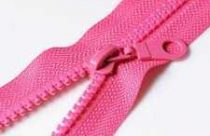 These plastic zippers have individually injected moulded teeth, fused directly on to the tape of the zipper. The High-performance resins used to manufacture moulded plastic elements are incredibly strong and make zippers that are durable, strong and flexible. These zippers are ideal for outerwear and heavyweight garments or any outdoor application.
These plastic zippers have individually injected moulded teeth, fused directly on to the tape of the zipper. The High-performance resins used to manufacture moulded plastic elements are incredibly strong and make zippers that are durable, strong and flexible. These zippers are ideal for outerwear and heavyweight garments or any outdoor application. The main categories of zippers, as described above, also include speciality zippers, which have special types of construction, or parts, or finishes. CFC zippers have a special class known as Invisible zippers due to the special construction and mode of use. These zippers do not require the provision of a fly since they are made and stitched in such a manner that only a hairline seam is visible from outside. These zips are predominantly used in ladies dresses and skirts. These zippers are available in knitted and woven tapes.
The main categories of zippers, as described above, also include speciality zippers, which have special types of construction, or parts, or finishes. CFC zippers have a special class known as Invisible zippers due to the special construction and mode of use. These zippers do not require the provision of a fly since they are made and stitched in such a manner that only a hairline seam is visible from outside. These zips are predominantly used in ladies dresses and skirts. These zippers are available in knitted and woven tapes.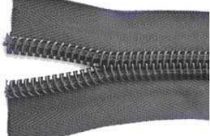 Coil zippers are made from a continuous coil of monofilament in place of individual teeth. Coil zippers are often referred to as nylon zippers. The teeth of these zippers are extruded nylon strip sewn onto the zipper tape. These zippers are very flexible and are available in a variety of sizes (gauges). Coil zippers have many applications from fashion-wear to all types of tents and canvas goods and bags.
Coil zippers are made from a continuous coil of monofilament in place of individual teeth. Coil zippers are often referred to as nylon zippers. The teeth of these zippers are extruded nylon strip sewn onto the zipper tape. These zippers are very flexible and are available in a variety of sizes (gauges). Coil zippers have many applications from fashion-wear to all types of tents and canvas goods and bags.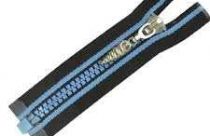 Closed-end zippers are non-separating and are normally opened and closed with a slider. The bottom stop is made up of a single part and doesn’t allow complete separation of the chain. These zippers are used on trousers, jeans, bags, boots, etc.
Closed-end zippers are non-separating and are normally opened and closed with a slider. The bottom stop is made up of a single part and doesn’t allow complete separation of the chain. These zippers are used on trousers, jeans, bags, boots, etc. Open-end (separating) zippers have separated ends. The ending part is joined by a box and pin mechanism provided on the lower end of the zipper. The zippers are closed using sliders and are normally used on jackets and other outerwear.
Open-end (separating) zippers have separated ends. The ending part is joined by a box and pin mechanism provided on the lower end of the zipper. The zippers are closed using sliders and are normally used on jackets and other outerwear.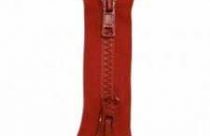 These zippers are made usually in #5 or larger sizes in CFC, plastic moulded and metal. The major applications are outerwear and luggage. These are made in X-type or Otype.
These zippers are made usually in #5 or larger sizes in CFC, plastic moulded and metal. The major applications are outerwear and luggage. These are made in X-type or Otype.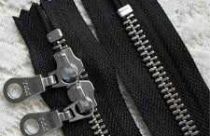 Two-Way head to head zippers has two sliders at the centre of the chain when the zippers are closed. Head to head zippers can be open-end by pulling the sliders towards the stops, but cannot be separated because the ending parts have two stops that cannot be divided. These zippers are mainly used for bags, backpacks, and luggage.
Two-Way head to head zippers has two sliders at the centre of the chain when the zippers are closed. Head to head zippers can be open-end by pulling the sliders towards the stops, but cannot be separated because the ending parts have two stops that cannot be divided. These zippers are mainly used for bags, backpacks, and luggage.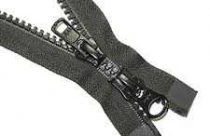 Two-way tail to tail (back to back) zippers has sliders on opposite ends when the zipper is closed. These zippers can be opened by pulling the sliders towards each other, but cannot be separated. They are used for overalls and anything else.
Two-way tail to tail (back to back) zippers has sliders on opposite ends when the zipper is closed. These zippers can be opened by pulling the sliders towards each other, but cannot be separated. They are used for overalls and anything else.
Jain Narrow Fabrics has truly mastered the art of knitted tapes. Their attention to detail and commitment to quality shine through in every product. Whether you’re looking for durable and reliable options for industrial applications or stylish and comfortable choices for fashion, Jain Narrow Fabrics’ knitted tapes are the epitome of craftsmanship. With a wide range of colors, patterns, and textures, they offer versatile solutions for various needs. Trust Jain Narrow Fabrics to elevate your projects with their exceptional knitted tapes – where innovation meets tradition.
Nice information about Zip Varieties for designers. Technology has improved fashion designing world to some height.
Thanks for the information. The need for fashion software and app updates Visit Fashion Dot will really help you a lot.
Nice illustration with images.
All the related articles are also informative.
I just love this site.
Thanks.
You may love also…
textileapex.blogspot.comYour blog
is enriched by so many useful contents. Luckily, I found it while I am
searching another topic in google. I will frequently visit your blog.
www.goldnfiber.comTextile relatedissues are little bit complicated, but you brief it soundly. Please carry on
your writing to deliver such interesting article.